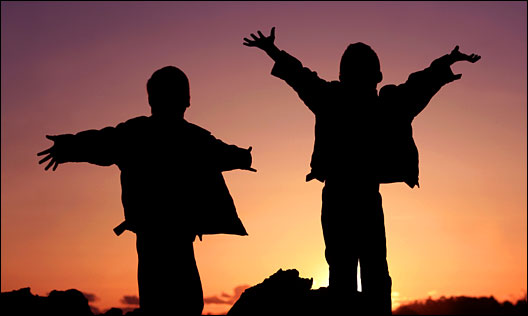
In past decades, when summer rolled around, parents told their children, “Go outside, and don’t come home ’til the street lights come on.”
In most neighborhoods, those days are unlikely to return anytime soon. Today, parents fear strangers and strange lawyers and nature itself. Though some of this trepidation is warranted, particularly in inner-city neighborhoods, much of that fear is ramped up by news and entertainment media. Meanwhile, an emerging body of evidence is illuminating the great benefits of nature experiences to children’s psychological and physical health, and their ability to learn.

Richard Louv.
What’s a parent to do? Certainly some of us can enroll our kids in a program — Scouting, a nature center, a summer camp, right? But the truth is that there aren’t enough programs to go around, and they’re not always an affordable option even when they’re available.
So Chip Donahue, of Roanoke, Va., has a suggestion.
A few weeks ago, Donahue, a second-grade teacher and father of three children (seven, five, and just under two years old), sent me an email. “After reading Last Child in the Woods,” he wrote, “my wife and I felt challenged to give back to our community and to encourage more families to get outside into our local parks.”
Over Christmas break, the Donahues sat down and mapped out places and a monthly adventure schedule for the coming year. They decided to invite their neighbors to join the first adventure. Donahue reports that his five-year-old son had an even better idea: “Dad, why don’t we invite everyone?” They sent a notice to the local paper, and to their surprise, five families the Donahues had never met showed up for the first event, which took place in January.
It was so cold that day that the group voted to stay inside, do a craft project, and read nature stories to the kids. But a voice of wisdom rang out — again from a child, this time a four-year-old girl. She walked up to Donahue and said, “Hey mister, when are we going outside?”
They bundled up and went out on a hike. Since then, the families always go outside, regardless of the weather.
Expanding their network, the Donahues launched a free monthly outdoor adventure club for families in the Roanoke Valley, and gave it a name: Kids In the Valley, Adventuring! “After word of mouth and two local newspaper articles, our membership has grown to 165 families,” Donahue reports. “We send out a monthly e-mail newsletter that lists recommendations for places for families to play and books to check out.” Through KIVA, families contact other families interested in meeting up. Some outings are focused on volunteer nature restoration projects, while others are devoted to just having fun.
“One important thing is that we have required that parents or guardians stay with their children at all times,” Donahue emphasizes. “We say, ‘Stay and make a memory with your child.’ The only thing we ask is that they consider joining us on volunteer days or finding another volunteer opportunity. There are so many beautiful free things to do outside.”
That’s good news during a recession.
Donahue’s venture isn’t unique. In the United Kingdom, families and individuals are banding together to create “green gyms” for regular outdoor exercise. And the California-based organization Hooked on Nature helps families and individuals form “nature circles” to meet and explore their relationship to nature.
And a few years ago, Laurel Dodge and Kathleen Diamond, two parent volunteers from the Orange County, New York Audubon Society, were concerned about how empty local trails had become. They initiated a free family nature study club called Nature Strollers. “Families flocked to our group, relieved to be able to take their kids on the trail without worry, finding that safety in numbers eliminated the need to be on constant guard,” Dodge reports. “Audubon, New York is already encouraging Audubon chapters and centers in our state to adopt the Nature Strollers model, and we’d like to spread it across the country.”
Family nature clubs aren’t the only solution to nature-deficit disorder. We need urban design innovation, greener schools, more nature centers, and other systemic changes. But programming alone can’t turn the tide. We also need deep cultural change, the kind that will increase the odds that individuals and families will take action on their own — or with a little help from their friends — without waiting for programs or funding.
Family nature clubs are a step in that direction — and they offer immediate gratification.
Parents, grandparents and even kids can create clubs quickly in any neighborhood, urban or suburban. This is an approach that can reduce fear and increase motivation. Think of how much easier it is to maintain regular gym visits if you’ve got an exercise buddy waiting for you every Wednesday. The same impetus can work for parents who want to give their children and themselves the gift of nature. If it seems daunting to do the planning and organizing yourself, try partnering with another family.
In the 1960s and 1970s, the Neighborhood Watch concept spread across the country, changing communities block by block and helping to restore the fabric that binds us all together. Family nature clubs could have a similar effect — and they’d be a lot more fun.


